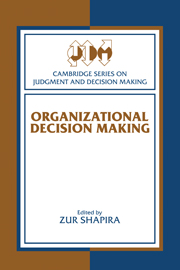Book contents
- Frontmatter
- Contents
- Series preface
- List of contributors
- Editor's preface
- Part I Introduction
- 1 Introduction and overview
- 2 Understanding how decisions happen in organizations
- Part II Information processing and attention allocation
- Part III Preference processing
- Part IV Decision processes
- Part V Alternative approaches
- Name index
- Subject index
1 - Introduction and overview
Published online by Cambridge University Press: 06 August 2010
- Frontmatter
- Contents
- Series preface
- List of contributors
- Editor's preface
- Part I Introduction
- 1 Introduction and overview
- 2 Understanding how decisions happen in organizations
- Part II Information processing and attention allocation
- Part III Preference processing
- Part IV Decision processes
- Part V Alternative approaches
- Name index
- Subject index
Summary
Organizational decision making can be looked at from various perspectives. This book attempts to increase our understanding of organizational decision making by bringing together researchers from two great traditions that share some common roots: behavioral decision theory and organizational decision making.
The roots of behavioral decision theory (Kahneman, 1991) include Edwards's (1954) studies of probability revision, Meehl's (1954) analysis of clinical judgment, Luce and Raiffa's (1957) description of game theory, and Simon's (1947, 1955) treatise on decision making in organizations. Over the last 40 years, research on the psychology of probability estimation and choice behavior led to the development of the heuristics and biases paradigm in the study of judgment under uncertainty (Kahneman, Slovic, & Tversky, 1982), as well as to the pursuit of prospect theory and framing in individual choice behavior (Kahneman & Tversky, 1984). Research in the behavioral decision theory tradition was carried on mainly in lab experiments and focused on the cognitive aspects of individual choice behavior. In the tradition of psychological science, the research was aimed at refuting the implications of the normative statistical decision theory's model. Over the years, behavioral decision theory produced a remarkable set of findings on individual choice behavior, albeit by neglecting the effects of social and emotional factors as well as the conflict inherent in decision making (Kahneman, 1991).
- Type
- Chapter
- Information
- Organizational Decision Making , pp. 3 - 8Publisher: Cambridge University PressPrint publication year: 1996
- 1
- Cited by



